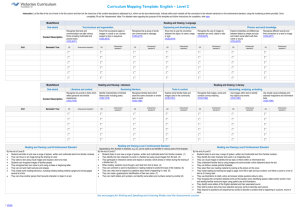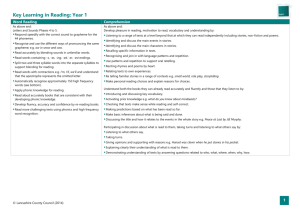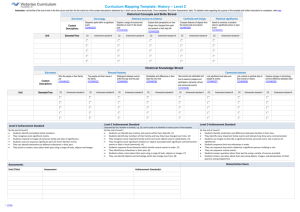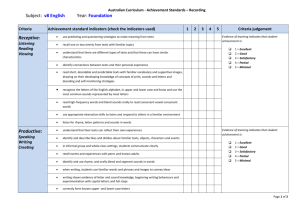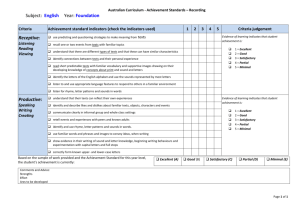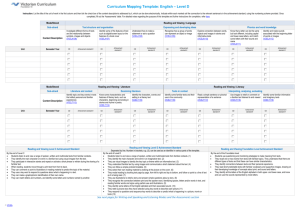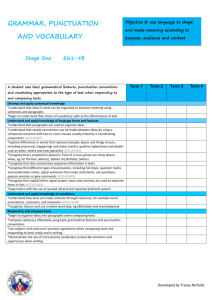Level B (docx
advertisement
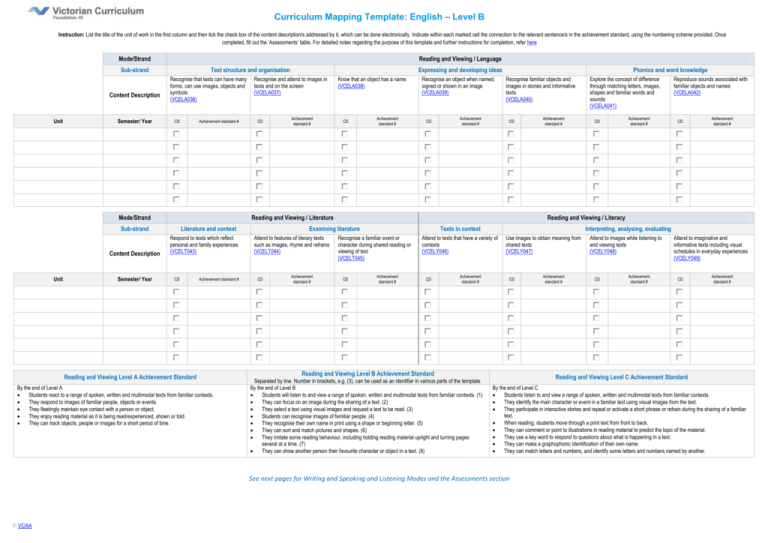
Curriculum Mapping Template: English – Level B Instruction: List the title of the unit of work in the first column and then tick the check box of the content description/s addressed by it, which can be done electronically. Indicate within each marked cell the connection to the relevant sentence/s in the achievement standard, using the numbering scheme provided. Once completed, fill out the ‘Assessments’ table. For detailed notes regarding the purpose of this template and further instructions for completion, refer here Mode/Strand Reading and Viewing / Language Sub-strand Content Description Unit Semester/ Year Text structure and organisation Recognise that texts can have many forms, can use images, objects and symbols (VCELA036) CD Achievement standard # Mode/Strand Unit Semester/ Year Recognise and attend to images in texts and on the screen (VCELA037) CD Achievement standard # Know that an object has a name (VCELA038) CD Achievement standard # Recognise an object when named, signed or shown in an image (VCELA039) CD Achievement standard # Phonics and word knowledge Recognise familiar objects and images in stories and informative texts (VCELA040) CD Reading and Viewing / Literature Sub-strand Content Description Expressing and developing ideas Literature and context Respond to texts which reflect personal and family experiences (VCELT043) CD Achievement standard # Reading and Viewing Level A Achievement Standard By the end of Level A Students react to a range of spoken, written and multimodal texts from familiar contexts. They respond to images of familiar people, objects or events. They fleetingly maintain eye contact with a person or object. They enjoy reading material as it is being read/experienced, shown or told. They can track objects, people or images for a short period of time. CD Achievement standard # Texts in context Achievement standard # CD Achievement standard # Recognise a familiar event or character during shared reading or viewing of text (VCELT045) CD Achievement standard # Interpreting, analysing, evaluating Attend to texts that have a variety of contexts (VCELY046) CD Achievement standard # Use images to obtain meaning from shared texts (VCELY047) CD Reading and Viewing Level B Achievement Standard Separated by line. Number in brackets, e.g. (3), can be used as an identifier in various parts of the template. By the end of Level B Students will listen to and view a range of spoken, written and multimodal texts from familiar contexts. (1) They can focus on an image during the sharing of a text. (2) They select a text using visual images and request a text to be read. (3) Students can recognise images of familiar people. (4) They recognise their own name in print using a shape or beginning letter. (5) They can sort and match pictures and shapes. (6) They imitate some reading behaviour, including holding reading material upright and turning pages several at a time. (7) They can show another person their favourite character or object in a text. (8) Achievement standard # Attend to images while listening to and viewing texts (VCELY048) CD Achievement standard # Attend to imaginative and informative texts including visual schedules in everyday experiences (VCELY049) CD Achievement standard # Reading and Viewing Level C Achievement Standard By the end of Level C Students listen to and view a range of spoken, written and multimodal texts from familiar contexts. They identify the main character or event in a familiar text using visual images from the text. They participate in interactive stories and repeat or activate a short phrase or refrain during the sharing of a familiar text. When reading, students move through a print text from front to back. They can comment or point to illustrations in reading material to predict the topic of the material. They use a key word to respond to questions about what is happening in a text. They can make a graphophonic identification of their own name. They can match letters and numbers, and identify some letters and numbers named by another. See next pages for Writing and Speaking and Listening Modes and the Assessments section © VCAA CD Reproduce sounds associated with familiar objects and names (VCELA042) Reading and Viewing / Literacy Examining literature Attend to features of literary texts such as images, rhyme and refrains (VCELT044) Achievement standard # Explore the concept of difference through matching letters, images, shapes and familiar words and sounds (VCELA041) Curriculum Mapping Template: English – Level B Mode / Strand Writing / Language Sub-strand Content Description Unit Semester/ Year Text structure and organisation Recognise the connection between an object, image and spoken word (VCELA050) CD Achievement standard # Phonics and word knowledge Recognise that text can be attached to images and recognise that people pause when talking and communicating (VCELA051) CD Achievement standard # Mode / Strand Unit Semester/ Year CD Recognise different sounds and words and their connection to objects and people (VCELA053) Achievement standard # CD Achievement standard # Select an image and illustration to represent a familiar literary text or recent event (VCELT054) CD Achievement standard # Creating texts Select image to be used in a short text about a special event (VCELY055) CD Achievement standard # When experiencing coactive writing activities, students make choices between objects and images and accept and reject objects and activities. Students develop their fine motor skills and hand-eye coordination and they move their hands in response to tactile stimuli. Students can demonstrate their grasp and can hold an object briefly when it is placed in their hand. Make simple choices during shared construction of personalised multimodal text (VCELY056) CD Writing Level A Achievement Standard Reproduce speech sounds to communicate basic wants and use images and objects to express their wants and ideas (VCELA052) Creating literature Writing / Literacy Sub-strand Content Description Writing / Literature Achievement standard # Grasp and move objects within and between their hands (VCELY057) CD Use software or applications to select images and sounds for shared texts (VCELY058) Achievement standard # CD Writing Level B Achievement Standard When writing, they can scribble freely using various materials or computer mouse. (9) Students draw non-linear shapes and forms. (10) They can use a touchscreen, press keys on keyboard and move a computer mouse. (11) They begin to hold and manipulate objects. (12) They assist in the construction of text by selecting images and topics through choice making. (13) Achievement standard # Writing Level C Achievement Standard When writing, students add writing such as scribble to label or comment on drawings, and imitate writing words and sentences. They express and record their wants and needs through a word, a picture or symbol selection. They demonstrate fine motor grasp and manipulating skills such as moving, picking up and manipulating objects. They can hold and use a pencil to make purposeful marks on paper. They apply colour to an outline and draw with purposeful direction. They can press a key for particular letters or functions on a keyboard and locate and click icons on the screen. They can select pictures that are important to create a picture storybook. See next page for Speaking and Listening Mode and Assessments section © VCAA Page 2 Curriculum Mapping Template: English – Level B Mode / Strand Speaking and Listening / Language Sub-strand Content Description Unit Semester/ Year Language variation and change Use sounds, gestures, images and facial expressions to communicate (VCELA059) CD Achievement standard # Language for interaction Recognise ways to gain and maintain attention (VCELA060) CD Mode / Strand Unit Semester/ Year Achievement standard # CD Responding to literature Identify a preferred text (VCELT065) Recognise the connection between words, images, sounds and everyday objects (VCELA062) CD Achievement standard # Connect sounds and words and match them to objects (VCELA063) CD CD Achievement standard # CD Students listen to and react to some familiar objects, people, words and sounds within the environment by turning head, looking, reaching out and/or vocalising. They respond to their name and to familiar items when named. Students show an interest in others and an awareness of everyday social interactions such as greetings by using gesture or vocalisation. They recognise that their reaction can change others’ behaviour. They can choose between objects, images and activities and accept or reject an object or activity. They withdraw attention if no longer interested in a topic of communication. Students attempt to imitate sounds. They have some consistent vocalisation and gestures in response to different people, activities and environments. Achievement standard # Participate in rhymes and songs from a range of cultures and echo some familiar rhythms and sound patterns (VCELT067) CD Achievement standard # Creating literature CD Achievement standard # Interacting with others Assist to modify a text by producing a sound, noise or using an object (VCELT068) CD Achievement standard # Students look towards and attend to significant people for short periods of time. (14) They attend to and respond to key word instructions. (15) They imitate familiar words, spoken and/or signed. (16) They use gesture or ‘yes’ or ‘no’ responses to answer a question or respond to an instruction. (17) They communicate basic wants and needs through the selection of objects, gestures, sounds, or action. (18) Students find and identify a variety of objects in their environment, choose an activity by pointing to an object, and point to objects as they are named by the teacher. (19) They communicate intentionally by using gesture, eye gaze or sound, or by selecting an object. (20) They follow a simple one-word instruction. (21) Listen to and respond to simple instructions (VCELY069) CD Speaking and Listening Level B Achievement Standard Achievement standard # Copy a sound (VCELA064) Speaking and Listening / Literacy Examining literature Respond to familiar images or sounds during shared reading/viewing of texts (VCELT066) Speaking and Listening Level A Achievement Standard Demonstrate a number of ways to indicate a choice (VCELA061) Phonics and word knowledge Speaking and Listening / Literature Sub-strand Content Description Achievement standard # Expressing and developing ideas Achievement standard # Respond to a presentation on an everyday experience (VCELY070) CD Achievement standard # Speaking and Listening Level C Achievement Standard Students listen to and interact with others. They use particular greetings to acknowledge people, respond with ‘yes’, ‘no’ or single words to indicate understanding and use a few words and simple phrases. They can share their favourite items or experience with a small group of students and respond to questions about it. They express and record their wants and needs through a word, picture or symbol selection. They can imitate initial word sounds and use photographs, pictures and symbols to represent people and things. They use and combine words, symbols and gestures that can be readily understood by others to make requests and to communicate needs. They make a request by linking key words, signs and/or symbols in a meaningful context. Assessments – across Reading and Viewing, Writing and Speaking and Listening Unit (Title) © VCAA Assessment Achievement Standard/s Unit (Title) Assessment Achievement Standard/s Page 3

